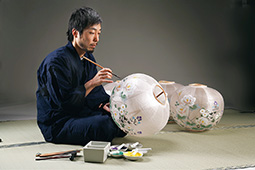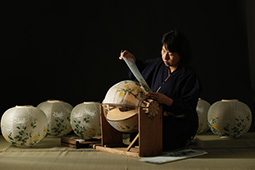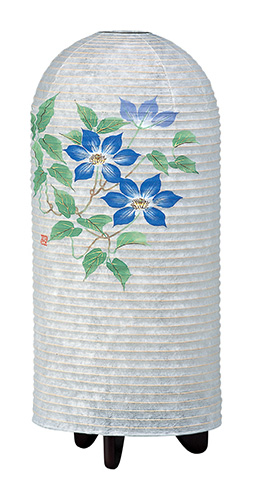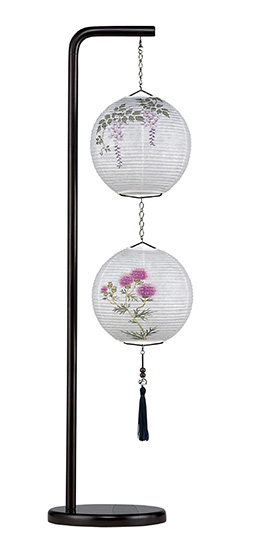July 2022
- English
- 日本語
The Traditional Light of Gifu Paper Lanterns

A Gifu paper lantern in a traditional Japanese living space 
Various Akari brand lamps designed by Isamu Noguchi

A Gifu paper lantern with a traditional design of chrysanthemums and other flowers 
An artisan painting designs on a Gifu paper lantern 
An artisan pasting washi onto the frame of a lantern 
A Gifu paper floor lantern painted with clematis flowers 
A Gifu paper lantern with a slender design that is a good fit for modern living spaces, painted with wisteria and thistle flowers

Gifu paper lanterns (Gifu Chochin) are made of thin washi handmade paper and thin strips of bamboo, and decorated with beautiful pictures. When they are lit, flowers, landscapes, and other colorful designs come into view bathed in soft light.

Seasonal flowers and landscapes are painted on thin, supple washi paper to create Gifu paper lanterns, which are widely treasured for their delicate beauty. When the light inside the lantern is lit, the sophisticated designs painted on the washi that surrounds the light source come to life in the soft glow. The traditional designs mainly feature combinations of flowers such as chrysanthemums and balloon flowers.
With a history dating back around 300 years, traditional Gifu paper lanterns are made from Mino washi and thin strips of bamboo, specialty products of the Mino region in Gifu Prefecture. The washi is extremely thin but strong and without irregularities, making it easy to paint and draw beautiful designs on the surface of the paper.
Gifu paper lanterns were awarded a Silver Medal at the Louisiana Purchase Exposition (St. Louis World’s Fair) in the United States in 1904, a Gold Medal at the World’s Fair in Liège, Belgium in 1905, and a Gold Medal at the International Exposition of Art and Technology in Modern Life in Paris in 1937. Highly regarded internationally, the lanterns developed as overseas orders continued to increase. In 1995, the Japanese government (Ministry of International Trade and Industry*) designated the Gifu paper lantern a National Traditional Craft.


Ozeki Morihiro, director of the Gifu Chochin Cooperative, comments, “The West has a traditional art of stained glass, in which pictures made from cut glass come to life when light passes through. I think the Gifu paper lantern of Japan has some similarities to that. People in the West also have a delicate sense of light, so they recognized the charm of the soft light passing through washi.”
Isamu Noguchi (1904–1988)**, the internationally renowned sculptor who also worked in garden design, interior design, and many other fields, was particularly attracted to Gifu paper lanterns. He visited the Gifu Chochin Cooperative, where Ozeki now serves as director, any number of times to study the production. In 1952, Noguchi launched his series of Akari (akari means light in Japanese) lanterns, which have been highly acclaimed at numerous exhibitions in the United States.

Ozeki comments, “Isamu Noguchi’s works brought out the charm of traditional Gifu paper lanterns in a new way. I have heard that he praised the light that passes through washi by saying, ‘There’s nothing better than this.’”
Influenced by Isamu Noguchi’s work and other new designs, young designers are launching one Gifu paper lantern after another featuring modern designs that match today’s lifestyle. Gifu paper lanterns are now attracting attention as new interior designs that are a good fit with the modern living space.


* Now the Ministry of Economy, Trade and Industry
** Isamu Noguchi was born in Los Angeles to a Japanese father and an American mother.

